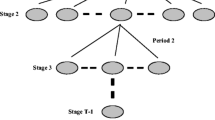Abstract
Greenhouse gas (GHG) emission reduction is usually associated with energy systems management. Management of regional energy systems is a complex task due to the strong interactions among energy supply, demand and conversion activities, as well as those among energy, environmental and economic factors. These complexities may be further compounded due to the presence of uncertainties in a variety of processes and the related costs, impact factors and objectives. Therefore, the objective of this study is to develop a dynamic interval-fuzzy two-stage stochastic regional energy systems planning model (DIFT-REM) and analysis GHG-emission reduction policies within a general energy management systems framework. The developed model is then applied to the Province of Ontario to demonstrate its applicability in supporting regional energy systems management and GHG-emission reduction analysis under uncertainty. The results indicated that DIFT-REM could address not only interactions among multiple energy-related activities, but also uncertainties in multiple forms and dynamics within a multi-period, multi-facility, multi-scale and multi-uncertainty context. The results also suggested that, when GHG-emission-credit trading is available for Ontario, the task of GHG-emission reduction could be accomplished with a lower system cost.
Similar content being viewed by others
References
Anderson LE (1968) A mathematical model for the optimization of a waste management system. SERL Report No. 68-1, Sanitary Engineering Research Laboratory, University of California, Berkeley, USA
Birge JR (1985) Decomposition and partitioning methods for multistage stochastic linear programs. Oper Res 33:989–996
Borges AR, Antunes CH (2003) A fuzzy multiple objective decision support model for energy-economy planning. Eur J Oper Res 145:304–316
Cormio C, Dicorato M, Minoia A, Trovato M (2003) A regional energy planning methodology including renewable energy sources and environmental constraints. Renew Sustain Energy Rev 7:99–130
Edirisinghe NCP, Ziemba WT (1994) Bounds for two-stage stochastic programs with fixed resources. Math Oper Res 19:292–313
Environment Canada (2007) Information on greenhouse gas sources and sinks. http://www.ec.gc.ca/pdb/ghg/ghg_home_e.cfm. Accessed April 2007
Fishbone LG, Abilock H (1981) MARKAL: a linear programming model for energy systems analysis: technical description of the BNL version. Int J Energy Res 5:353–375
Forrest JJH, Tomlin JA (2007) Branch and bound, integer, and non-integer programming. Ann Oper Res 149:81–87
Gassmann HI (1990) MSLIP: a computer code for the multistage stochastic linear programming problem. Math Program 47:407–423
Grohnheit PE, Mortensen BOG (2003) Competition in the market for space heating—district heating as the infrastructure for competition among fuels and technologies. Energy Policy 31(9):817–826
Henning D, Amiri S, Holmgren K (2006) Modelling and optimisation of electricity, steam and district heating production for a local Swedish utility. Eur J Oper Res 175 (2):1224–1247
Huang GH, Loucks DP (2000) An inexact two-stage stochastic programming model for water resources management under uncertainty. Civ Eng Environ Syst 17:95–118
Huang GH, Baetz BW, Patry GG (1992) Grey linear programming approach for municipal solid waste management planning under uncertainty. Civ Eng Syst 9:319–335
Huang GH, Baetz BW, Patry GG (1993) A grey fuzzy linear programming approach for municipal solid waste management planning under uncertainty. Civ Eng Syst 10:123–146
Huang GH, Baetz BW, Patry GG (1994) Grey dynamic programming for waste-management planning under uncertainty. J Urban Plann Dev 120:132–156
Inuiguchi M, Ichihashi HI, Tanaka H (1990) Fuzzy programming: a survey of recent development. In: Slowinski R, Teghem J (eds) Stochastic versus fuzzy approaches to multiobjective mathematical programming under uncertainty. Kluwer, Dordrecht, pp 45–70
Kanudia A, Loulou R (1999) Advanced bottom-up modeling for national and regional energy planning in response to climate change. Int J Environ Pollut 12:191–216
Khella AFA (1997) Egypt: energy planning policies with environmental considerations. Energy Policy 25(1):105–115
Lin QG, Huang GH (2008) IPEM: an interval-parameter energy systems planning model. Energy Sources, Part A: Recovery, Utilization, and Environmental Effects 30:1382–1399
Lin QG, Huang GH (2009a) A dynamic inexact energy systems planning model for supporting greenhouse-gas emission management and sustainable renewable energy development under uncertainty—A case study for the City of Waterloo, Canada. Renewable and Sustainable Energy Reviews 13:1836–1853
Lin QG, Huang GH (2009b) An inexact stochastic energy systems planning model for managing energy systems and greenhouse gas emissions in the municipality of Beijing. Energy Policy 37:4463–4473
Lin QG, Huang GH, Bass B (2004) Power challenge for a cleaner energy future in Saskatchewan, Canada. International Journal of Computer Applications in Technology 22:151–159
Lin QG, Huang GH, Bass B, Chen B, Zhang BY, Zhang XD (2008) CCEM: a city-cluster energy systems planning model. Energy Sources, Part A: Recovery, Utilization, and Environmental Effects 31:1–14
Lin QG, Huang GH, Bass B, Qin XS (2009) IFTEM: an interval-fuzzy two-stage stochastic optimization model for regional energy systems planning under uncertainty. Energy Policy 37:868–878
Maqsood I, Huang GH, Zeng GM (2004) An inexact two-stage mixed integer linear programming model for waste management under uncertainty. Civ Eng Environ Syst 21(3):187–206
Mavrotas G, Demertzis H et al (2003) Energy planning in buildings under uncertainty in fuel costs: the case of a hotel unit in Greece. Energy Convers Manag 44:1303–1321
Natural Resources Canada (2007) Energy use and consumption. http://nrcan.gc.ca/eneene/statstat/index-eng.php. Accessed 14 May 2007
Ontario Ministry of Finance (2009) Ontario fact sheet, September 2009. http://www.fin.gov.on.ca/english/economy/ecupdates/factsheet.html
OPA (2007) A progress report on electricity supply. Ontario Power Authority, Canada
Ruszczynski A, Swietanowski A (1997) Accelerating the regularized decomposition method for two-stage stochastic linear problems. Eur J Oper Res 101:328–342
Sadeghi M, Hosseini HM (2006) Energy supply planning in Iran by using fuzzy linear programming approach: regarding uncertainties of investment costs. Energy Policy 34:993–1003
SES Canada Research Inc. (2007) Canadians do not want Kyoto ratification until impact known. SES Canada Research Inc., Ottawa
Unger T, Ekvall T (2003) Benefits from increased cooperation and energy trade under CO2 commitments—the Nordic case. Climate Policy 3(3):279–294
Author information
Authors and Affiliations
Corresponding author
Rights and permissions
About this article
Cite this article
Lin, Q.G., Huang, G.H. Interval-fuzzy stochastic optimization for regional energy systems planning and greenhouse-gas emission management under uncertainty—a case study for the Province of Ontario, Canada. Climatic Change 104, 353–378 (2011). https://doi.org/10.1007/s10584-009-9795-8
Received:
Accepted:
Published:
Issue Date:
DOI: https://doi.org/10.1007/s10584-009-9795-8




